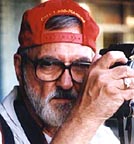|
|
|
|
the Journalist in the Field, Part II by Roger Williams |
 |
| In this
part, we will examine the licensing procedure for the journalist, or any
individual, to obtain an entry level license for amateur radio. We will
also review some of the purposes for amateur radio communications.
It must be understood that amateur radio is not meant to take the place of commercial radio or business systems. Amateur radio is to augment a journalist's communications capabilities, allowing him or her to have an inexpensive and simple method of general communication. The Novice License: In order to receive a Novice license you must pass a 35-question written exam in basic electronics theory, operating procedures, and federal communications regulations. It is necessary to answer 26 out of the 35 questions or 74%. You may opt to take a Morse code test at five words per minute. This can be to your advantage in pursuing a higher level license. The Technician License: If you are not interested in learning Morse code at the initial testing time, the Technician license is the way to go. This license will permit you to have the localized, and sometimes longer-distance communications discussed in Part I (see the May issue). To receive this license the applicant must pass the same 35-question written exam, as discussed for the Novice license, plus an additional 30-question Technician exam. This exam is simply a rehash of the first 35 questions, but in more detail. To pass this section it is necessary to correctly answer 22 of the 30 questions. Technician level license holders have full amateur privileges on a number of amateur radio bands, and can carry on general communications with other licensed amateurs. This is the level of licensing needed for the type of communications discussed in Part I. The license exams are given by teams of volunteer examiners accredited by the American Radio Relay League. These examiners have been accredited, and operate by appointment in most areas of the country. There is usually no charge for taking the license exams, and they can be taken again if you fail. However, most pass the first time around. The American Radio Relay League publishes a book called Now You're Talking, which contains "All You Need To Get Your Ham Radio Technician License." You can purchase this moderately priced manual at most two-way radio stores. Operating as a Member of the Amateur Radio Community Amateur radio operators come from all walks of life, and the journalist who decides to use this tool will meet and share ideas with many different people "over the air." Amateurs are involved in life and property-saving exercises throughout the country. If you are interested, you can also become part of a vast disaster preparedness network. And, be able to report on the "who, what, where, when, and why" of what goes on during and after a disaster. Amateurs are involved in everything from boating accidents to typhoons, hurricanes and earthquakes. The first hurricane during which I used my radio was the one that hit Miami in October 1950--it was among the worst storms in this country's history. The amateurs worked hand in hand with the Red Cross --reporting weather changes, directing emergency crews and, in general, supporting the efforts of local authorities. Remember, this was 1950--still the Dark Ages of personal electronic communication. I also used my radio during the aftermath of the PSA crash, in San Diego, in the late '70s. The amateur radio community came together quickly--through the ease of communication--to support the authorities in many ways. The amateurs were the first on the scene, and set up the initial communications systems. Among other things, they took part in directing the fire vehicles to the scene, and setting up perimeters to keep the public away. Today, we have more formal organizations such as the Radio Amateur Emergency Services (RACES), and Amateur Radio Emergency Services (ARES). Both trained by local police and fire departments, they assist in everything from search and rescue, to general field support as needed. They work together with local, state and federal emergency service organizations. As a journalist, becoming part of these amateur radio groups gives you a leg up during any disaster situation. The Role of the Journalist in Amateur Radio The journalist, as radio amateur, benefits because of the unique communications he can maintain with other journalists; his increased awareness of what is going on in the community (amateurs are into everything); and his participation in support of the community's needs. Radio amateurs (called "Hams") participate in many community events, parades and beauty contests--not only disasters. Journalists occupy a unique place in the community--they are information providers. Amateur radio can allow journalists to communicate better in all the ways I have mentioned, not only for the benefit of their profession, but also for the benefit of the public. As a Ham, you will never be alone with a flat tire again. Not only will someone come to help, but you'll probably get donuts to munch on as well. That's the amateur community doing its thing. Next time, we'll discuss equipment, operation and costs. Send any questions or comments to me at Radioman@pressroom.com. All input, especially from the amateur radio members of the media is welcomed. |
|